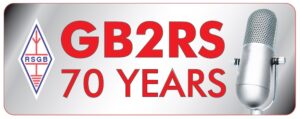

Peter GM4DTH, our local GB2RS news reader in Edinburgh, writes:
I operated GB70RS, which is the callsign to celebrate 70 years of the RSGB GB2RS news service, when weather permitted, from 1 to 7 September. Most of my planned operation was on HF from an out-of-doors station near my flat. The reason for the location is simply the levels of interference. At home the interference on all bands well exceeds strength 9. My portable location has about strength 5 noise on the transmit aerial which is about 40m long. A separate active receive aerial drops this to a much lower level enabling reception. During my station development tests the signal levels around the UK were reasonable and workable but not strong in the eastern USA. VHF and UHF was operated from the home location, by request.
(Full report by Peter at bottom of this article).

 Mains isolation transformer.
Mains isolation transformer.

Receive – Active Dipole.

Transmit Feed-Point
Full report by Peter:
Throughout 2025 the RSGB is celebrating seventy years of its regular news broadcasts using the callsign GB2RS. All those involved with this service were given the opportunity to have a weeks operation using the special event style callsign GB70RS. As I broadcast the news serving the eastern side of central Scotland I was eligible to use this callsign. Earlier in the year it was used by my colleagues over in the western side and also from Tayside. To maximise UK coverage I decided that HF operation would be the best way to achieve this.
I have no operational HF station where I stay due to excessive QRM, which exceeds S9, on all frequencies up to and beyond 30MHz. However, I do have access to a garden area across the road and I decided to develop a transportable station. Being out of doors and exposed I chose the summer months to develop the station and prove that the plan was viable. I rigged a 40m length of wire over the trees at about 16m above ground sloping down to the step up transformer at 8m over the ground. This was mounted on a fibreglass pole. The thinking behind this configuration was to avoid requiring having a good RF ground system which is needed for current driven aerials. Tests were carried out over the summer months using the Sunday afternoon news net around 16:00. The results showed that it was possible but was subject to the summer propagation with fading over the more distant stations. Not all were workable. I decided that the beginning of September would be the best week to operate as the propagation was improving and the weather remained fair.
The station was comprised of two distinct components AF and RF. The RF was an Elecraft K3 transceiver which is well known and used to be the choice of dxers. It also has transformer based 3.5mm line audio connections. Strangely the TRS line connector was not configured for a balanced input. I added an external transformer to balance the connection. This allowed me to use the broadcast headset which I use for my news transmissions. Optimising ‘talk power’ and audio is a subject that is often discussed by radio amateurs. My approach was to adopt the method chosen by many broadcast stations. I am lucky enough to have an old ex BBC World Service Orban Optimod-HF 9015A speech processor which I used to increase my ‘talk power’. The on air quality was checked by a local station Briain GM8PKL who is exceptionally well skilled with audio matters. My headset and the receiver audio were connected to a Sound Devices 442 portable mixer and the audio was logged by a Sound Devices 744 field recorder. I used a dual needle Peak Programme Meter (PPM) to monitor my levels. The red needle showed the level into the Optimod and the green needle showed the output being fed to the K3. One could quickly see that the Optimod was performing as designed. I decided that the BBC were more skilled than myself at setting it up so I left all the settings well alone. The K3 ran around 80 Watts output, with no ALC action, and there was a standard Bird 43 Thruline checking the aerial matching. The feeder cable was RG-142 (this is an old designation which most RF users would be familiar with). The RF connectors were N Types and a BNC. The noise level on this wire aerial was about S5. To improve the signal to noise ratio I used an short active dipole which greatly improved the readability of the received stations.
I kept my operations to the 7MHz band and I was able to operate most afternoons for the week. On the Wednesday it rained and there was no operation. On Sunday I planned to join the afternoon 5MHz net but it started raining about 15:30. and, instead, the station was quickly dismantled.
I worked about thirty stations on 7 MHz and going was rather slow, so no pile up or contest style operating was needed. This gave a more relaxed style to the QSOs made. The propagation was variable and there was fading on many of the UK stations worked. At around 17:00 the propagation started to change with more distant stations from the continent emerging. This was the time to close down. In addition to the HF a number of stations were worked before and after my Sunday morning broadcast.
So in the end I made a small contribution towards celebrating the seventy years of the RSGB’s news service.
